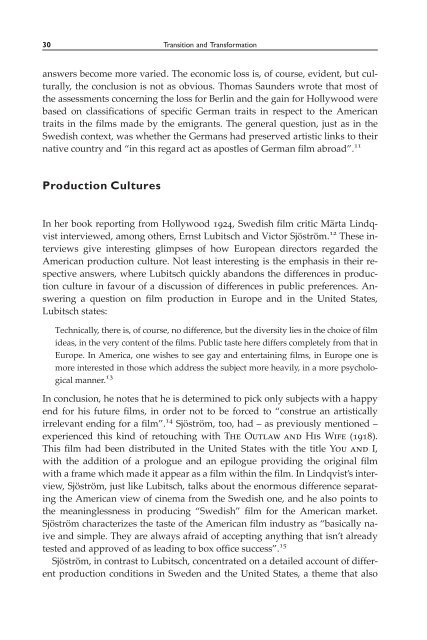FILM FILM - University of Macau Library
FILM FILM - University of Macau Library
FILM FILM - University of Macau Library
Create successful ePaper yourself
Turn your PDF publications into a flip-book with our unique Google optimized e-Paper software.
30 Transition and Transformation<br />
answers become more varied. The economic loss is, <strong>of</strong> course, evident, but culturally,<br />
the conclusion is not as obvious. Thomas Saunders wrote that most <strong>of</strong><br />
the assessments concerning the loss for Berlin and the gain for Hollywood were<br />
based on classifications <strong>of</strong> specific German traits in respect to the American<br />
traits in the films made by the emigrants. The general question, just as in the<br />
Swedish context, was whether the Germans had preserved artistic links to their<br />
native country and “in this regard act as apostles <strong>of</strong> German film abroad”. 11<br />
Production Cultures<br />
In her book reporting from Hollywood 1924, Swedish film critic Märta Lindqvist<br />
interviewed, among others, Ernst Lubitsch and Victor Sjöström. 12 These interviews<br />
give interesting glimpses <strong>of</strong> how European directors regarded the<br />
American production culture. Not least interesting is the emphasis in their respective<br />
answers, where Lubitsch quickly abandons the differences in production<br />
culture in favour <strong>of</strong> a discussion <strong>of</strong> differences in public preferences. Answering<br />
a question on film production in Europe and in the United States,<br />
Lubitsch states:<br />
Technically, there is, <strong>of</strong> course, no difference, but the diversity lies in the choice <strong>of</strong> film<br />
ideas, in the very content <strong>of</strong> the films. Public taste here differs completely from that in<br />
Europe. In America, one wishes to see gay and entertaining films, in Europe one is<br />
more interested in those which address the subject more heavily, in a more psychological<br />
manner. 13<br />
In conclusion, he notes that he is determined to pick only subjects with a happy<br />
end for his future films, in order not to be forced to “construe an artistically<br />
irrelevant ending for a film”. 14 Sjöström, too, had – as previously mentioned –<br />
experienced this kind <strong>of</strong> retouching with The Outlaw and His Wife (1918).<br />
This film had been distributed in the United States with the title You and I,<br />
with the addition <strong>of</strong> a prologue and an epilogue providing the original film<br />
with a frame which made it appear as a film within the film. In Lindqvist’s interview,<br />
Sjöström, just like Lubitsch, talks about the enormous difference separating<br />
the American view <strong>of</strong> cinema from the Swedish one, and he also points to<br />
the meaninglessness in producing “Swedish” film for the American market.<br />
Sjöström characterizes the taste <strong>of</strong> the American film industry as “basically naive<br />
and simple. They are always afraid <strong>of</strong> accepting anything that isn’t already<br />
tested and approved <strong>of</strong> as leading to box <strong>of</strong>fice success”. 15<br />
Sjöström, in contrast to Lubitsch, concentrated on a detailed account <strong>of</strong> different<br />
production conditions in Sweden and the United States, a theme that also

















